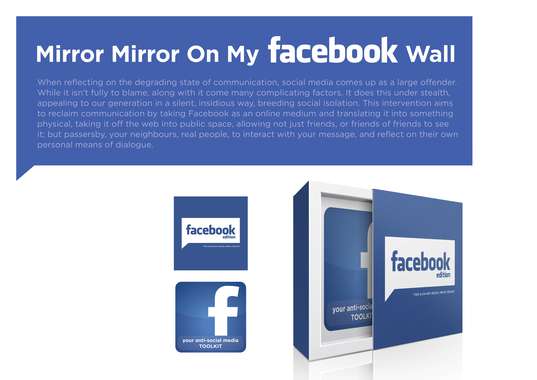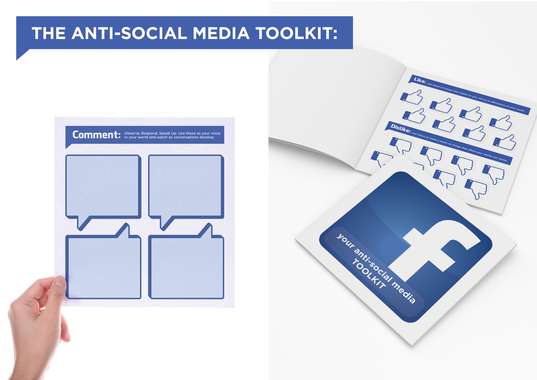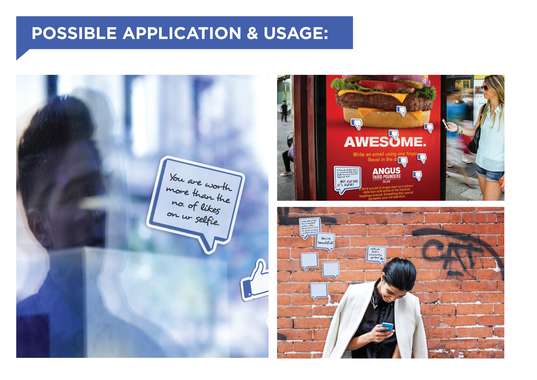Mirror Mirror on my Facebook Wall
by SL
This work has not been commented by curators.
Title
Mirror Mirror on my Facebook Wall
Headline
An Anti-Social Media Toolkit (Facebook Edition)
Concept author(s)
Sara Leow
Concept author year(s) of birth
1989
Concept author(s) contribution
Conceptualisation was developed and under-girded by research and personal interest in how design can be utilised in social circles. Full involvement and undertaking in conceptualisation, relevant research, design and execution.
Concept author(s) Country
Australia
Friendly Competition
Radical intimacies: dialogue in our times (2014)
Competition category
Visual communication practice
Competition subcategory
static
Competition field
academic
Competition subfield
student
Subfield description
Swinburne University, Bachelor of Design (Communication Design - Honours)
Check out the Radical intimacies: dialogue in our times 2014 outlines of Memefest Friendly competition.
Description of idea
Describe your idea and concept of your work in relation to the festival outlines:
When reflecting on the decreasing state of intimacy in our communication, social media comes up as a large offender. While it isn’t fully to blame, along with it come many complicating factors. It operates stealthily, appealing to our generation in a silent, insidious way, breeding social isolation. This intervention aims to reclaim intimacy in dialogue by taking social media (in this case: Facebook) as an online medium and translating it into something physical, taking it off the monologue of web-space into public-space, allowing not just friends, or merely friends of friends to see it; but passers-by, your neighbours, real people, to interact with your message, and collectively reflect on our own personal means of dialogue. Running along the theme of: “Mirror Mirror on the Wall, Who’s the most beautiful of them all?”- the ideology of individualism, vanity, inward-focused self esteem and the constant monologue that Facebook breeds.
What kind of communication approach do you use?
I laboured to employ a dialogic approach to this communication design work. Only then can we can work toward design messaging that is open, relational and generative; and opens up communication that is open and interpersonal. By using visual elements that mimic the various social media platforms of our time (i.e Facebook/ Twitter / Instagram etc); and taking these digitized forms, then translating them into a physical format (stickers). It is important that meaning is therefore constructed in the dialogue between this design and the audience.
What are in your opinion concrete benefits to the society because of your communication?
This work seeks to extend the walls of communication beyond a person's online medium and be brought to the physical space of this world we live in. This stems from an observation that is reflective of our society; that has been accustomed to this anti-social manner of communicating, and to raise what I’d term as the 3A’s: Awareness (of the common trappings of social media and communications), Aversion (Both a logical and emotional responses agree to this entrapment), Alternative (an invitation to engage in real world conversations that span beyond their narrowed social circle). This also reflects on communication designers and how the nature of our thinking needs to be critical rather than merely unassuming or agreeable.
What did you personally learn from creating your submitted work?
That we as a human society thrive on dialogue with each other, but ironically, distance and isolate ourselves from this selfsame thing. I've learnt as an application to my personal practice as a design student, to not let my designs be ignorant of the effect on dialogue and relationships, and that one must not merely design for oneself. Similarly, with content offered up on our social media Walls; we cannot afford to be only talking to ourselves.
Why is your work, GOOD communication WORK?
Personally, good communication work aids in facilitating conversation, and initiating change for the better. This is resoundingly aligned with the Memefest brief of Radical intimacies: Dialogue of our times. While some may argue people only recognise good design, it is easy for us to become accustomed to bad design too. As such, we also become desensitized to the lack of intimacy in our dialogue because of our extensive engagement with social media. With my work I hope to use this existing medium and turning it around to reclaim what good communication is - allowing viewers to be partakers and partners.
Where and how do you intent do implement your work?
The medium of vinyl stickers is intended for easily application onto any surface in public spaces. Particularly walls (akin to the Facebook Wall) or reflective surfaces that encourage visibility, participation and reflection. Because social media platforms are accessed worldwide – the visual language adoption of these iconic (symbols and colours) can be applicable to various countries and cultures that are besmirched by this online isolating and growingly ignorant culture.
Did your intervention had an effect on other Media. If yes, describe the effect? (Has other media reported on it- how? Were you able to change other media with your work- how?)
This intervention has had opportunity to be put up on some streets in Melbourne and has raised public attention, also gathering some topic contributions and social awareness of thoughts that concern the urban Melbournian (for example; community gardens in cities and crowds on public transport). I hope to continue this intervention beyond the Memefest submission deadline.








